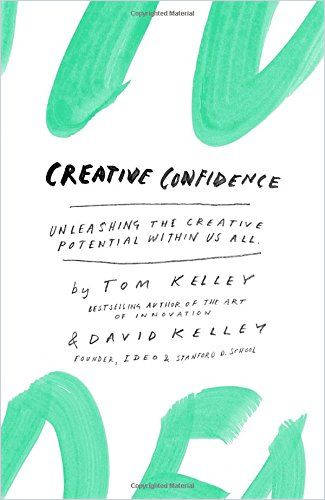The renowned Kelley brothers of IDEO fame condense their inspirational approach to personal creativity into a workable, fun manual for everyone.

Find Your Creativity
David and Tom Kelley, partners in the innovation and design firm IDEO, are titans of innovation. David created Stanford University’s d.school to teach design thinking. Tom is an executive fellow at the Haas School of Business at the University of California, Berkeley.
Innovation…can happen anywhere. It’s fueled by a restless intellectual curiosity, deep optimism, the ability to accept repeated failure…a relentless work ethic and a mind-set that encourages not just ideas, but action.Tom Kelley and David Kelley
The Kelleys argue that you are creative and so is everyone else. In fact, you must regard yourself as creative to seize opportunities for innovation. Tom and David Kelley have, for three decades, chipped away at the “creativity myth” that claims only people in certain artistic fields are creative.
Creative Confidence
The Kelleys advocate organization-wide creative confidence. Rather than relegating creative types to peripheral roles, infuse creativity throughout your company.
Design thinking taps into each person’s intuitive ability to identify patterns and construct useful ideas. Human-centered design focuses on users’ needs. The greatest creative opportunities lie in developing the human factors of collaboration, imagination and empathy. Start there in your organization.
Dare to Create
The Kelleys urge you to build and nurture your creative confidence as you would strengthen a muscle. Exercise your confidence by coming up with innovative ideas, approaches and solutions. Act on your ideas so you realize the value of your creative powers. For greater success, try more creative endeavors and remember that early failure in an innovative process can prove critical to its ultimate success.
Everybody is the creative type.Tom Kelley and David Kelley
Fear of failing can impede you from gaining new skills or taking on new tasks. Creative confidence helps you overcome those fears. Acknowledging your mistakes helps you avoid cover-ups, guilt or rationalization. Call your next new idea an experiment to lower peer expectations and allow you to learn without damaging your career.
Getting over a failure or a fear can drive positive changes in your life. The authors recommend taking on increasingly difficult challenges, persevering and staying resilient. Move beyond your doubts about your creative ability and beyond fears of failure, of judgment, of starting a project or of the unknown.
Spark
Cultivate your creative spark by increasing your daily dose of inspiration. Decide to become more creative and to think like a traveler so you regard your familiar surroundings anew. The Kelleys teach that insight strikes when you relax your mind to let it create connections between disparate tasks. Pose a series of “why” questions to go below the surface of any idea. Encourage collaboration among all the departments in your organization.
Leap
The Kelleys offer concrete methods for turning your thoughts into actions. For example, to document potentially excellent innovations, create quick prototypes. Follow Boyle’s law, named for Dennis Boyle, one of IDEO’s master prototypers:
Never go to a meeting without a prototype.Boyle’s Law
Prototypes can include quickly produced videos, mock-ups of apps, foam core build-outs of an interior office layout or a movie-style storyboard that illustrates a new service. Sketch ideas on a whiteboard. Build a prototype of a project even if you don’t show it to anyone. Instead of bringing a PowerPoint presentation to your next meeting, bring a single image and share a compelling story.
“Heart/Dollar Seesaw”
Decisions often involve delicate balances among competing interests, potentially including your individual passions, your general happiness, your company’s culture and the financial benefits of the various choices that keep a business operational. The authors acknowledge that balancing this heart/dollar seesaw can be difficult. Avoid suffering the trap of being caught at your current level of competence; instead rely on your ever-increasing skills to advance up and away from an unfulfilling career path.
Creatively Confident Groups
Innovation occurs routinely in environments that nurture creativity. As a leader, your attitude cultivates a creatively confident team. The Kelleys urge you to find out who’s doing creative work in any department in your company and then enable and empower these innovators to share ideas with you and your team.
Design thinking helps to foster creative cultures and build the internal systems required to sustain innovation. Tom Kelley and David Kelley
Be aware of the moments when you feel most alive. Remember who you are with, what you loved about the situation and what you might replicate in other circumstances.
Work through creativity challenges to build your creative muscles. The value doesn’t reside in the idea, but in taking action to work on it. For example, try the “15 Seconds of Brilliance” exercise: Make an immediate note of any flash of creativity, dream or idea that darts through your short-term memory. Exemplifying his belief in this process, David Kelley keeps a whiteboard marker at hand to take notes in the shower.
A Creative Objective
The Kelleys challenge you to apply what you glean from their manual to a creative project. Set a creative objective, and pursue it step by step. Don’t judge or limit yourself. Generate out-of-the-box ideas. Jump into the goals you value most. Build on your experiences.
Once you start to think about your life and career as just another creative challenge, many different possibilities may come to light. Tom Kelley and David Kelley
Guard against inertia by moving forward. The authors remind you that you must become your primary creative challenge. Open yourself to innovation and imagination.
Fun
The Kelleys wrote this stimulating manual for anyone who’s ready to take creativity and innovation to a new level – individually or company-wide. They offer an evergreen approach with staying power for building creativity in yourself, your team and your organization. Their affirming, encouraging guide offers dynamic examples of creativity in action and engaging exercises to help you and your colleagues develop creativity. Masters of innovation and of inspiring innovation, the Kelleys draw on their great sense of fun and their irreverence to convince you – and they will – that there is nothing intimidating about connecting to and trusting your creative processes. This is an easy, amusing read that you will return to with a smile whenever your creativity or courage lags.
Tom Kelley also wrote The Ten Faces of Innovation and The Art of Innovation. Other worthwhile books on developing an innovative workplace include The Innovator’s Dilemma by Clayton M. Christensen; The Curve Ahead by Dave Power; and Hooked by Nir Eyal.








